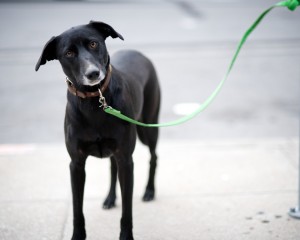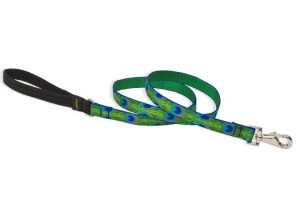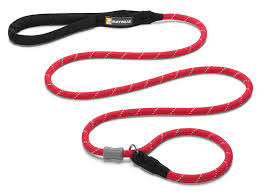Dog Leashes – The Good, The Bad, and the Ugly
 When you add a new furry family member to your home, it’s a good idea to develop a walking schedule with a goal of loose-leash walking. For more information about loose-leash walking and it’s importantce, check out this helpful article by Dr. Sophia Yin.
When you add a new furry family member to your home, it’s a good idea to develop a walking schedule with a goal of loose-leash walking. For more information about loose-leash walking and it’s importantce, check out this helpful article by Dr. Sophia Yin.
Between my client’s dogs and my own two, a large part of my day is spent walking dogs, and I have experience with many types of leashes. Now let’s compare the different types of leashes.
High Quality Fabric or Leather Leash
Pros: Long lasting; length and width can be customized to your dog’s size and temperament; cost effective as they typically last the life of your dog.
Cons: Without proper training, your dog may pull on the leash and end up taking you on a walk, instead of vice versa.
Our Top Pick:

Lupine leads feature a padded handle and are guaranteed for life – even if chewed through! Click here to purchase.
Training Leash
Pros: A good first leash for a puppy; lightweight; helps teach loose-leash walking.
Cons: Must be properly positioned high on the dog’s neck, behind the ears, or will be ineffective.
Our Top Pick:

Just-a-Cinch by Ruffwear is our top pick for a training leash and collar combo. Click here to purchase.
Chain Leash
Pros: Virtually indestructible.
Cons: Heavy for both the dog and the handler; may choke the dog.
Retractable Leash, or Flexi Leash
Pros: Allows your dog to explore.
Cons: Offers no training benefit because your dog can freely pull on the leash; easily winds around people, other dogs and objects, possibly causing injury to dog and/or handler; the “lock” and “release lock” buttons may get stuck, which can be unsafe for the dog.
Long Line Leash
Pros: A great training tool to teach your dog to “come” when called.
Cons: Inappropriate for daily walks as it may become tangled around people, other animals and objects; has no benefit for loosh-leash training.
Stay tuned for the second part of this series, where we will discuss the best harnesses for your dog.
What leash do you prefer to use with your dog? Tell us in the comments!
